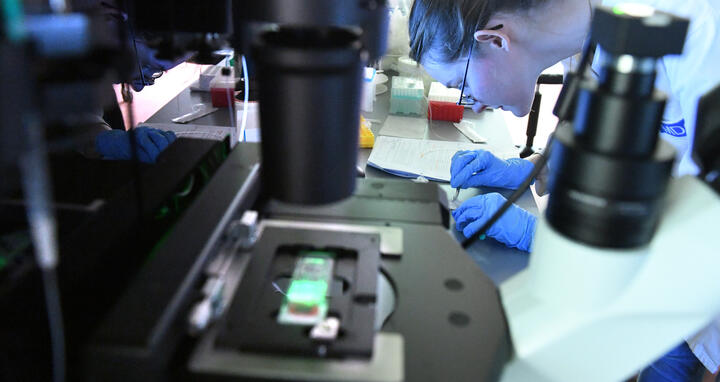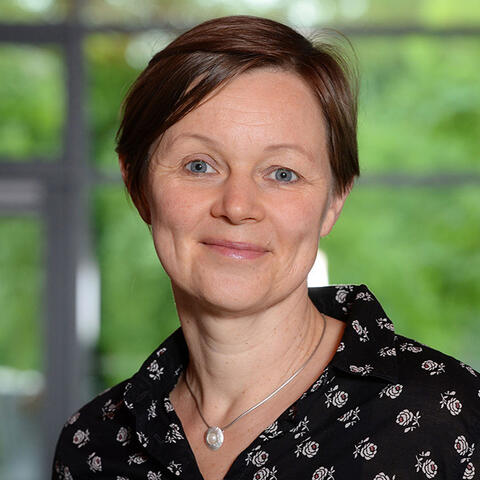Researching in tandem
Anyone seeking to analyze the molecular mechanisms of health and disease needs powerful tools and specialized methodological expertise. The technology platforms at the Max Delbrück Center cover a wide spectrum of fields, ranging from imaging techniques and high-throughput analyses to bioinformatics, stem cell technologies and animal models. They are available to both scientists at the Max Delbrück Center and external project partners.
Dr. Jutta Steinkötter.
Dr. Jutta Steinkötter heads the Scientific Infrastructure Department, which oversees the teams of the different technology platforms who work closely with the Center’s research labs to jointly provide, develop and apply specific technologies to scientific questions.
Steinkötter , who has a PhD in biology, has worked as a science manager at the Max Delbrück Center since 2007. From 2008 she coordinated the development of the Berlin Institute for Medical Systems Biology of the Max Delbrück Center (MDC-BIMSB), and in 2017 took over the executive management of the Center’s scientific infrastructure. In an interview with her colleague Dr. Manuel Ehling – who is also a biologist – she talks about how so-called tandem projects between research labs and technology platforms aim to spur on the development of cutting-edge methods at the Center.
How much money did the Max Delbrück Center put towards new equipment and technologies in 2022?
Jutta Steinkötter: The Max Delbrück Center was able to invest heavily in this area last year. We even had far more money available to spend on such resources than in previous years. We are naturally pleased that this was possible, as state-of-the-art technology enables us to advance our research. We were able to use a substantial portion of the funds – around €14 million – directly for scientific equipment. We have purchased large-scale equipment and cutting-edge technologies for various fields, such as electron microscopy and other high-performance optical microscopes. But we have also expanded or modernized our technological resources in the areas of proteomics, genomics, flow cytometry, and animal phenotyping.
An electron microscope for €1.3 million
What was the biggest purchase?
Jutta Steinkötter: An electron microscope with a €1.3 million price tag, for our Electron Microscopy Platform headed by Séverine Kunz.
For the first time, €300,000 were earmarked for tandem projects. What is this is all about?
Jutta Steinkötter: The investments I mentioned earlier are going into cutting-edge technologies. These naturally require a high level of technical and scientific expertise. Only then can these technologies be optimally applied to the biomedical questions and experiments being undertaken by our research labs. The methods, protocols, and experiments, as well as the evaluation of the data, usually require specific training prior to use. The equipment manufacturers normally provide such training, and then all users of the technology gain initial experience in pilot experiments and establishment trials. It is also often necessary to test the chemicals used in the applications. The technology platforms have to devote resources, that is, time and money, to all of these activities, because such start-up phases are cost-intensive.
You can achieve more together than alone
And so that’s how the idea for holding a call for tandem projects came about?
Jutta Steinkötter: The decision was made during discussions with the heads of the technology platforms. Despite the very positive outlook, they took a rather cautious view of the investments. On the one hand, of course, everyone was excited about the promising possibilities, but on the other hand, they also wanted to make sure that the technologies would then be used by the teams in the best possible way to tackle research questions. To ensure this, the platform teams need training, time, and consumable materials so that they can explore all the technical and scientific possibilities. We therefore wanted to carry out pilot projects alongside the investments and support the implementation of the new technologies with financial and staff resources. Our tandem concept foresees scientists from the research labs working closely with experts from the technology platforms. The tandem can jointly develop new protocols and methods, which are then made available to all researchers at the Max Delbrück Center. We provide funding for these joint experiments.
Another goal is to ensure that the equipment is put into operation straight away. It is important that the methodological knowledge gained from the pilot experiments be made available as quickly as possible to many other users. We also want scientists from all interested labs to participate. It would be great if this would lead to a think tank of sorts for innovations, ideas for third-party funding applications, or the like.
How many tandem teams have applied for project funding?
Jutta Steinkötter: We were pleasantly surprised at how well the idea was received and how lively the initial discussions were. This alone has enabled us to get research labs and technology platforms to jointly explore the new possibilities and discuss potential applications. And these preparations resulted in us receiving a great variety of project proposals. These included proposals from all the different areas in which investments were made.
Manuel Ehling: There were 23 proposals for tandem projects whose budgets totaled €674,000. The Scientific Infrastructure Board then selected 13 projects to be supported from the €300,000 pot of available funding. A total of seven technology platforms and twelve research labs are involved in the selected tandem projects.
Getting the most out of our investments
What criteria were used to select the projects? And what happens next?
Jutta Steinkötter: The most important requirement was of course that the tandem project proposal involve a collaboration between a research lab and a technology platform or even a collaboration with two platforms. It was also important to us that they develop new methods and protocols that are also of interest to other research labs and that can be used in follow-up projects for third-party funding applications or that they have a high transfer potential. Simply put, the tandem projects should help us get the most out of our investments.
After completion of the projects or after a maximum of one year, we ask the tandem project teams to submit a short, concise report. This should include a presentation of the results and of the developed protocols as well as a discussion of further possibilities. We also make a point of having the tandem project teams present their results in our technology platform seminar series. This raises the visibility of the projects and makes the methods quickly accessible to other labs.
Will there be funding available for tandem projects again this year?
Jutta Steinkötter: That would be nice – but of course that mainly depends on whether we receive funding again and how successful our current tandem projects have been. But I can already say that the first run-through has set a lot of things in motion and facilitated fruitful collaborations. Now we hope that the projects will also yield great results. After all, that is our mission: to make the best possible use of public funds available for investment purposes and thus create an optimal environment for our researchers. Jana Ehrhardt-Joswig conducted the interview.






